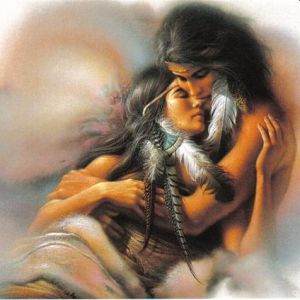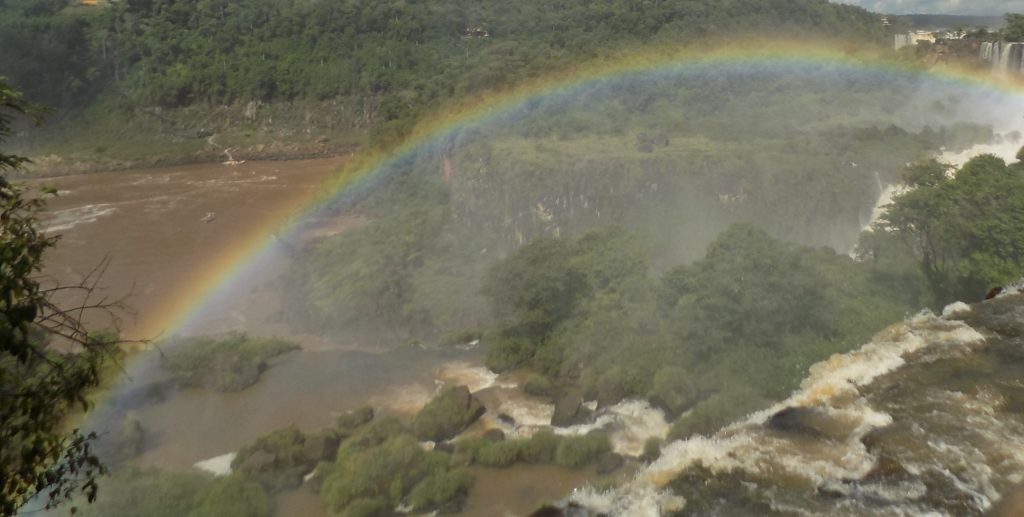The Abá (Guaraní).
Guaraní is the common term used to identify the people indigenous to the area in and around Iguaçu. It’s generally believed that they are culturally related to the Tupi who settled in the Amazon rainforest around 900 BCE but they then gradually migrated south. The name Iguaçu derives from the Guaraní (or Tupi) words ‘y’ meaning water and ‘ûasú’ meaning big. (Because it’s common and accepted usage today, I will generally refer to these native people as Guaraní. I need to note, however, that before their encounters with the Spanish they referred to themselves as Abá or simply “the people” and because Guaraní is a term applied by Jesuit missionaries to people they were able to convert to Christianity I will use Abá where I deem it appropriate.)
For the Abá, the supreme god of all creation is Tupã. Tupã descended from the heavens to the earth where, from a hill in the Aregúa region (in modern day Paraguay), it created nearly all the living things on Earth and placed the stars in the sky. Then, in a solemn ceremony, Tupã formed the clay statues of a man and a woman, breathed life into the figures, left them with the spirits of good and evil, and returned to the heavens. These original humans were called Rupave or Father of the People and Sypave or Mother of the People. They had three sons and an unspecified number of daughters. Kerana, the daughter of their second son gave birth to the seven monsters of Abá legend and we will meet one of them in the story of the falls. All other civilizations came after the Abá.
Naipi and Taruba.
According to Abá legend, a beautiful woman called Naipi was walking along the river some days before she was to marry a great warrior named Taruba who was from a neighboring tribe.

[Image from Tours And Vacations for Women.]
As she walked, Mbói Tu’ī the god of waterways and water creatures fell in love with her reflection and demanded the tribal elders give her to him. Fearing his wrath, the tribe agreed to her sacrifice.
Hearing this, Taruba determined he would rescue Naipi and arranged to meet her in a canoe on the river believing he could outrace the serpent god. As Taruba set out, Mbói Tu’ī gave chase but Taruba was, indeed, able to maintain distance between his canoe and the serpent. A furious M’Bói expanded his body to the width of the river and, as he slithered after Taruba, he formed new curves on the river.
Still unable to catch the lovers, M’Boi split open the earth ahead of Taruba who was thrown onto an embankment as the canoe plunged into the chasm. Seeing Naipi trapped in the canoe which was about to smash into the land below, M’Boi turned the woman into a rock.
Taruba tried to rush to her but M’Bói pulled his hands into the earth on the opposite side of the falls. There they became rooted as Taruba transformed into a palm tree and M’Bói had his revenge.
M’Bói, it is said, still lurks deep in the waters of Devil’s Throat watching the palm tree and the rock and making sure they never unite. The lovers’ spirits remain fixed in place – one in a rock and one in a palm tree. They can see one another but cannot touch. Or can they?
There is another part of the legend that says a rainbow spanning the river is the lovers reaching out to each other.
From Brazil you can see Argentina.
As I noted previously, our flight left Rio Saturday morning for the roughly two-hour hop to Foz do Iguaçu and from our hotel we rode another 40 minutes to the national park.
(The Falls are within national parks in both Brazil and Argentina. The Brazilian park covers nearly 170,000 hectares while the smaller Argentine park protects another 55,000 hectares. Both parks are UNESCO World Heritage sites. They are considered semi-deciduous subtropical rainforests and are home to many rare and endangered species of plants and animals.)
Entering the park, we were immediately greeted by signs warning us not to feed an animal well known to those of us in the U S who like crossword puzzles – the coati. Coatis are members of the raccoon family and like their cousins are both omnivorous and advantageous feeders. The coatis of Iguaçu are thoroughly habituated to humans. They show no fear and some can be rather brazen in their approach – particularly to humans with food. We, on the other hand, needed to be cautious around them because not only can they transmit diseases but their bite and claws can do rapid and painful damage.
Jan shot and shared a video of coatis feeding on a fallen coconut that I’ve included in my photo album.
In addition to the coatis, we saw black vultures soaring on the thermal currents, a unique cicada, and a tegu. However, for me, the highlight of the fauna we saw Saturday came when we returned to the parking lot and our driver pointed us toward a family of capybaras – a mother and three babies. It’s not that the capybara – the largest rodent in the world – is particularly rare and I’d seen one in captivity at Keepers of the Wild on my 2017 trip to Arizona. However, it’s always more interesting to see animals in their natural habitat. I had dead batteries in my camera but once again managed to take a few pictures with my phone.
We had dinner just around the corner from the hotel at Churrascaria do Gaúcho. A churrascaria is, more or less, a Portuguese barbecue. Like most modern restaurants of this type, Churrascaria do Gaúcho offers a buffet but unlike a typical buffet serves its meat rodízio style. This means passadores (meat waiters) come to every table and, if the diner accepts what they’re offering, will thinly slice barbecued meat directly from the skewer onto the diner’s plate. The best passadores not only slice the meat thinly but do so with flair. While Jan, Jill, and I all approached the meal temperately, our guide Berner attacked it ravenously. Come Sunday, he felt some twinges of regret for that.


